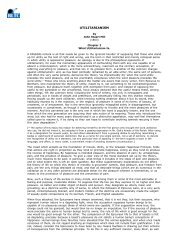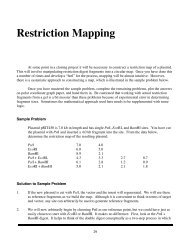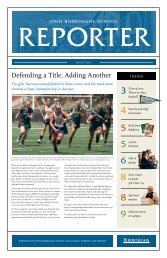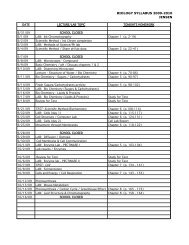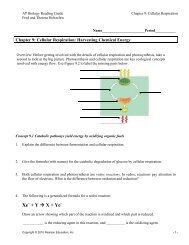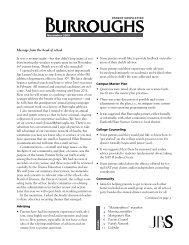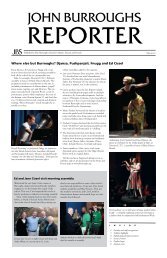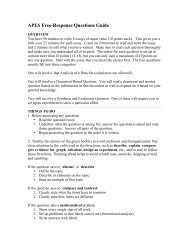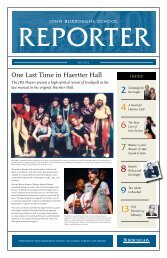1940s A Decade of Domination - John Burroughs School
1940s A Decade of Domination - John Burroughs School
1940s A Decade of Domination - John Burroughs School
Create successful ePaper yourself
Turn your PDF publications into a flip-book with our unique Google optimized e-Paper software.
game, same result: <strong>Burroughs</strong> by 37–29. There were tense moments as the Bombers trailed by six to start the fourth quarterbut scored fourteen straight points to win.By now the little-school-that-could, <strong>Burroughs</strong> rode the train and an 18–2 record to Springfield, Missouri, for the sixteenteamstate championship. There they would mingle with schools that had won thirty games and more. <strong>Burroughs</strong> snappedRepublic’s nineteen-game streak in the first round 55–44 behind Ben Bishop’s twenty-three points. Next came Bowling Greenwith a 34–1 record. In front <strong>of</strong> a crowd <strong>of</strong> 5,000, the Bombers charged to a 27–16 halftime lead and scored fifteen straightpoints in the third quarter to win 54–40.The magical run ended on a Saturday afternoon with a 39–38 loss to Buffalo, the eventual state champions. “We came outflat,” recalled Sisler. More importantly, four regulars—all but Bishop—fouled out <strong>of</strong> the game. “The Bombers led in field goalscoring fifteen to thirteen but failed to hit accurately from the charity stripe,” reported the World. An apparent buzzer-beaterby sixth-man Rod Wagner ’50 was disallowed as too late. <strong>Burroughs</strong> partisans seriously questioned the refereeing. Accordingto one second-hand report, the <strong>of</strong>ficials believed they had lost control <strong>of</strong> the Bowling Green game due to the <strong>Burroughs</strong>fast break, so they wanted to slow the Bombers down in the Buffalo matchup. Disheartened, <strong>Burroughs</strong> lost the consolationgame by precisely the same score to Bonne Terre on a free throw in the last minute.Sisler made first-team All-State and All-District and was named the St. Louis Star-Times’ prep player <strong>of</strong> the year, leading thedistrict in scoring with eighteen points per game. Bishop made second-team All-State while Burst and Thies received All-League recognition.A strong ABC adversary <strong>of</strong> the 49ers later became a valued friend <strong>of</strong> <strong>Burroughs</strong>. F. Morgan “Buzz” Taylor, a three-sport athleteat Western Military Academy, became the roommate <strong>of</strong> Dave Sisler, Chuck Thies and Lew Petring, all ’49, at Princeton,where he played football and nearly made the 1952 Olympic team in the long jump. Taylor married Barbara Olin ’50. In 2006,Buzz, Barbara, and Barbara’s sister, Judy Olin Higgins ’54, gave significant support to the now-pending new Haertter Hall, andTaylor dedicated part <strong>of</strong> the gift to his wife and his three close <strong>Burroughs</strong> friends.INDIVIDUAL ACCOLADESThe tradition <strong>of</strong> honoring a girl and boy for their athletic careers at <strong>Burroughs</strong> continued in the <strong>1940s</strong>, a much-anticipatedaward announced at the athletic banquet following Field Day each spring. For the girls, the honor was called the “physical educationaward.” Beginning in 1941 and proceeding chronologically, the recipients were Margery Dodson ’41, Elizabeth Rickey’42 (the sixth and last <strong>of</strong> Branch Rickey’s athletic children at <strong>Burroughs</strong>), Emily Freund ’43, Jane Cutts ’44, Madeline Haertter’45, Elizabeth “Ibby” Gray ’46, Joy Glik ’47, Carolyn “Callie” Costen ’48, and Mary Christy Gordon ’49.The award was important in part because the limited interscholastic play for the girls meant scant opportunities for publicrecognition. Varsity hockey played only a few games a year—mostly against Principia—and the win-loss record <strong>of</strong> the<strong>1940s</strong> fell <strong>of</strong>f sharply from the prior decade. In addition, varsity programs in other sports—basketball and tennis—developed late. Girls sports, nonetheless, remained an integral part <strong>of</strong> school life, due in part to the leadership <strong>of</strong>Athletic Director Alice Beaman. “Miss Beaman was instrumental in encouraging all the girls to be athletic,” recalledVirginia Staten ’46, one <strong>of</strong> George Staten’s daughters. “It was the thing to do.” Janey Studt ’46 concurred. “I playedeverything,” she related. “It will always be a big part <strong>of</strong> my life.”Field Day was a prime opportunity for the girls to display their talent. “I achieved a goal I had always wanted,” saidStaten, “I set a record in the high jump. But then my sister (Sharlee Staten ’49) came along and broke it—eventhough she was shorter.”Sharlee Staten was one <strong>of</strong> a host <strong>of</strong> talented girls in the Class <strong>of</strong> 1949. Ben Bishop wrote <strong>of</strong> his female classmates:“Had Jane Hill, Margie Pruett, Sharlee Staten and Christy Gordon been allowed to compete in boys’ sports, ourjobs would have been in real jeopardy.” In their junior year, the girls <strong>of</strong> ’49 placed seven <strong>of</strong> their number onthe hockey varsity, and their senior-year record <strong>of</strong> 3–1 was the best <strong>of</strong> the decade, with scoring by Staten, Hill,Elizabeth Kotsrean, Marion Streett, and Barbara O’Neil.Major accolades came early in the decade for a <strong>Burroughs</strong> alumna, Margaret Cornwell ’33. After a superiorhockey career at Sweetbriar, she toured Central and South America as part <strong>of</strong> a U.S. nationalteam. She continued play for a Midwest sectional team, along with two other <strong>Burroughs</strong> alumnae,Alice Rickey ’35 and Elizabeth Lockett ’34, and in 1941 and 1942 she was named to the All-Americanteam <strong>of</strong> the United States Field Hockey Tournament and Convention. At the time, she was assistingin girls’ athletics at <strong>Burroughs</strong>.For the boys, the individual achievement award was dubbed “most valuable player.” In 1941, it wasshared by Bob Zelle and Carl Messinger. The Scott brothers, Dave and Bill, won it in 1942 and 1946 respectively.Other winners were <strong>John</strong> Martin ’43, Ted Royston ’44, Rowland Dodson ’45, Robert Maune ’47,and Sam Grant ’48. With the abundance <strong>of</strong> talent in the Class <strong>of</strong> 1949, the judges threw up their hands and spreadthe honor among Jim Burst, Ben Bishop, Doug Montgomery, Dave Sisler, Dick Strassner, and Chuck Thies. Burst becamea four-sport standout at Washington University and was an inaugural inductee in the Bears’ Sports Hall<strong>of</strong> Fame. Sisler led Princeton in basketball and baseball, followed by a stellar big-league pitching career.66 JOHN BURROUGHS /67



